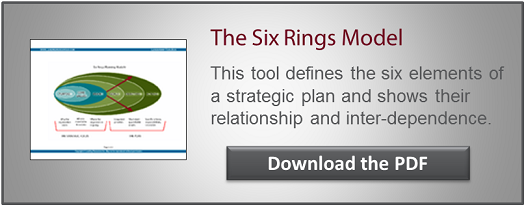Systems thinking discovers patterns of assumptions that may have been invisible.
We refer to these as “frames.”
In the field of cognitive science, it’s well understood that frames influence how people think about a particular issue or problem. If you’re not attentive to frames and how they affect you, the result can be a dizzying mish-mash.
You can control your frame.
The art of systems thinking is to make sense of it all by realizing that you can control your frame, and that each of these frames carries with it benefits as well as assumptions that can lead to good decisions or errors in judgment.
The Strategic Frame
For example, the benefit of the strategic frame is that it enables you to take the long view and identify changes you have to undergo in order to achieve an important goal. Dirk Robertson used the strategic frame to re-conceive his business. But the strategic frame may cause you to over-estimate the power you have to shape markets and overlook fundamental changes in the patterns of purchasing. American automakers made this mistake when they failed to see the shift away from SUVs starting in 2004.
The Process Frame
In the process frame, people can become so focused on reducing cycle time or improving efficiency that they forget to focus on what customers actually want. This is the problem faced, for example, by the fast food industry. McDonald’s became very efficient in delivering Big Macs and Quarter Pounders, yet all the while its relative share of the market continually declined.
The Leadership Frame
In the leadership frame, people focus too much on one person, often at the expense of understanding the importance of good dynamics within the team. When Michael Eisner hired Michael Ovitz as president of Disney Corp, Disney’s CEO thought he was getting someone who could be a successful number two. Much to Eisner’s surprise, none of Eisner’s lieutenants wanted to work with Ovitz. Eisner’s short-sighted decision cost Disney hundreds of millions of dollars when it was forced to buy out Ovitz’s contract.
The Performance Frame
In the performance frame, people overly focus on performance without looking at other circumstances. Capital One, for example, changed the terms on its credit cards without notifying consumers during the financial meltdown of 2008-2009. It then jacked up the interest rates on those same consumers to unconscionably high levels, losing its most creditworthy customers. By putting numbers ahead of relationships, Capital One managed its way deeper into financial crisis.
Each of these is an example of colliding frames, where the snapshot of the situation is overly-simplified, and a more nuanced understanding would lead to more judicious decisions.
In high-performing organizations, people learn how to identify – and eliminate – these patterns of unproductive thinking.
They use systems thinking instead, stepping back and looking at a situation from multiple frames and choosing the right course based on a more nuanced understanding of what’s going on.
This article was syndicated from Business 2 Community: The Art of Systems Thinking
More Business & Finance articles from Business 2 Community:





